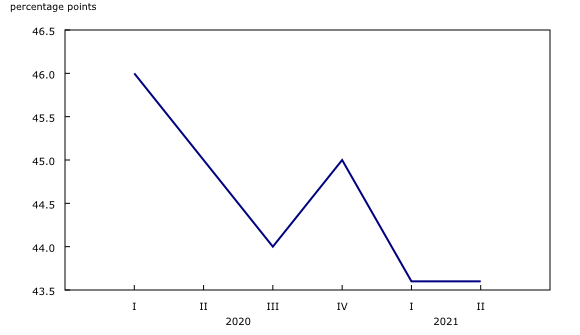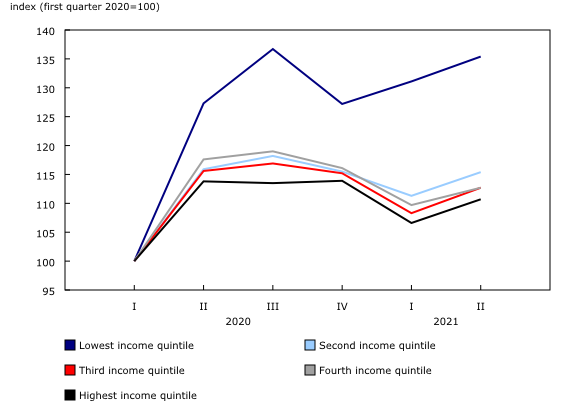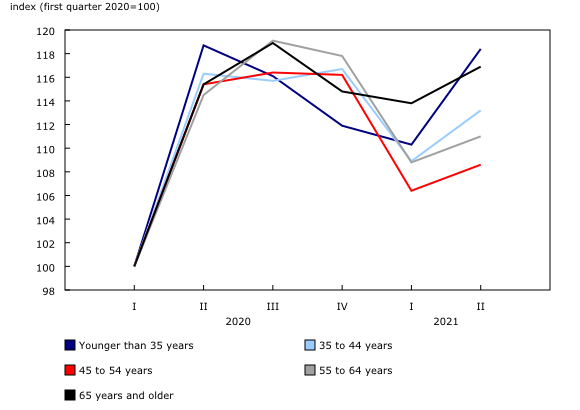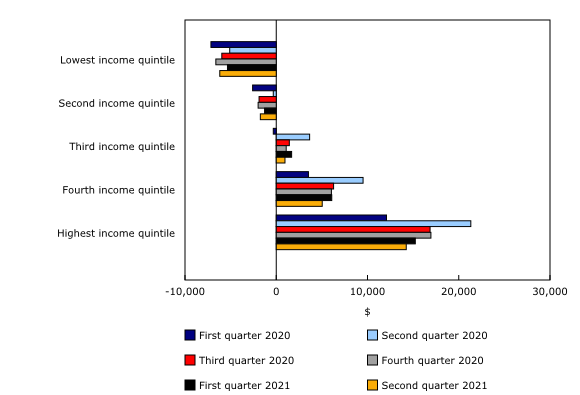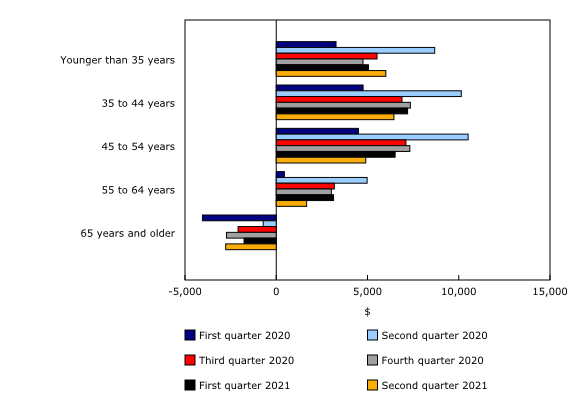Distributions of household economic accounts for income, consumption and saving of Canadian households, first and second quarters of 2021
Archived Content
Information identified as archived is provided for reference, research or recordkeeping purposes. It is not subject to the Government of Canada Web Standards and has not been altered or updated since it was archived. Please "contact us" to request a format other than those available.
Released: 2021-10-26
Household income inequality was at the lowest level ever recorded since the beginning of this data series in 1999. Household disposable income increased in both the first and second quarters of 2021 for the lowest-income households. Households in all other income quintiles recorded lower disposable income in the first quarter, followed by higher income in the second quarter. The result of these changes was a further decline in the gap between the top two and bottom two income quintiles' share of total disposable income over the first half of 2021.
While the distributions of household economic accounts provide important insight into the trends in household economic well-being and income inequality in Canada, the results in this release focus on the changes in income, consumption and saving for groups or average households with specific socioeconomic characteristics. It is important to recognize that not all households, even those with similar characteristics, necessarily experience the same economic or financial situations.
Higher wages drive growth in disposable income for lowest-income households over the first half of 2021
Since the beginning of the pandemic, lower-income households consistently recorded higher growth in their disposable income compared with households in other income quintiles. This trend was also observed in the first half of 2021, as disposable income for the lowest-income households rose 3.0% and 3.3%, respectively, in the first two quarters, while income for the highest-income households fell 6.4% and then rose 3.9% over the same period.
The primary contributor to the differences between the lowest and highest income quintiles over the first half of 2021 was compensation of employees. The lowest income quintile had higher growth in employee wages, rising 5.1% in the first quarter and 8.7% in the second quarter, whereas over the same period, they fell 0.9% and rose 0.1% for the highest-income households. During this time, the lowest wage earners saw stronger gains in their hours worked relative to the highest wage earners, as many lower-paying jobs are in frontline essential services, like grocery stores, and were not affected by pandemic-related shutdowns.
Another contributing factor to the differences between the lowest and highest income quintiles was current transfers received, which, relative to the fourth quarter of 2020, were up for all households in the second quarter of 2021, except those in the middle income quintile. The lowest-income households recorded the largest cumulative increase in current transfers received over the first half of 2021. Notably, the impact of increased current transfers is much more significant for lower-income households, as these transfers represent a far greater share of their disposable income than for higher-income households. For example, the share of current transfers received relative to total disposable income over the first half of 2021 was 85% for the lowest-income households, while it was 16% for the highest-income households.
Youngest households see larger growth in disposable income in the first two quarters of 2021 compared with older households
At the beginning of the pandemic, in the second quarter of 2020, the youngest households in Canada recorded larger increases in disposable income compared with older households. Once again, in the first half of 2021, households with a major income earner younger than 35 years of age recorded the largest gains in disposable income. However, unlike in 2020, when the growth in disposable income was solely driven by increased current transfers received, the 2021 gains were the result of both higher compensation and increased transfers received.
Net saving improves the most for the youngest households in the first half of 2021
Households in the two lowest income quintiles were the only ones to improve their cumulative net saving over the first half of 2021 compared with the last quarter of 2020, as they spent less and earned more in compensation. All other quintiles saw a decline in their net saving, as higher spending occurred alongside declines in disposable income. Despite a decrease in net saving in the second quarter of 2021, middle-income households still recorded positive net saving, something they had not done at any time prior to the pandemic.
The youngest households—those with a major income earner younger than 35—were the only ones to record an increase in their net saving over the first half of 2021, as growth in their disposable income outpaced growth in their spending. All other households recorded a decline in their net saving in the first half of 2021 as their disposable income declined alongside higher spending.
Note to readers
Statistics Canada regularly publishes macroeconomic indicators on household disposable income, final consumption expenditure and net saving as part of the Canadian System of Macroeconomic Accounts (CSMA). These accounts are aligned with the most recent international standards and are compiled for all sectors of the economy, including households, non-profit institutions, governments and corporations, along with Canada's financial position vis-à-vis the rest of the world. While the CSMA provides high-quality information on the overall position of households relative to other economic sectors, the distributions of household economic accounts (DHEA) provide additional granularity to address questions such as vulnerabilities of specific groups and the resulting implications for economic well-being and financial stability. These accounts are an important complement to standard quarterly outputs related to the economy.
The DHEA estimates released today provide estimates of income, consumption and saving and their sub-components by various household distributions for the first and second quarters of 2021. In addition to these new estimates, a few consumption series were revised for 2019 and 2020 to account for refined information regarding expenditures abroad. These revisions impacted the household final consumption expenditure, actual household final consumption and net saving estimates for 2019 and 2020.
As with all data, the DHEA estimates are not without their limitations. While some distributions are estimated using timely microdata or micromodels, such as wages and salaries, others, including household final consumption expenditure, rely on assumptions or use data from prior reference periods. Users should keep these limitations in mind when analyzing the estimates included in this release.
All values are expressed in quarterly nominal unadjusted rates, unless otherwise specified.
Products
Details on the sources and methods behind these estimates can be found in the publication Methodological Guide: Canadian System of Macroeconomic Accounts (13-607-X). See the section "Distributions of Household Economic Accounts'' under Satellite Accounts and Special Studies.
The Economic Accounts Statistics Portal, accessible from the Subjects module of our website, features an up-to-date portrait of national and provincial economies and their structure.
The Latest Developments in the Canadian Economic Accounts (13-605-X) is available.
The User Guide: Canadian System of Macroeconomic Accounts (13-606-G) is available.
Contact information
For more information, or to enquire about the concepts, methods or data quality of this release, contact us (toll-free 1-800-263-1136; 514-283-8300; STATCAN.infostats-infostats.STATCAN@canada.ca) or Media Relations (613-951-4636; STATCAN.mediahotline-ligneinfomedias.STATCAN@canada.ca).
- Date modified:


